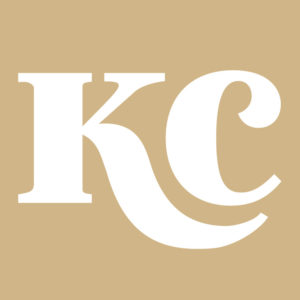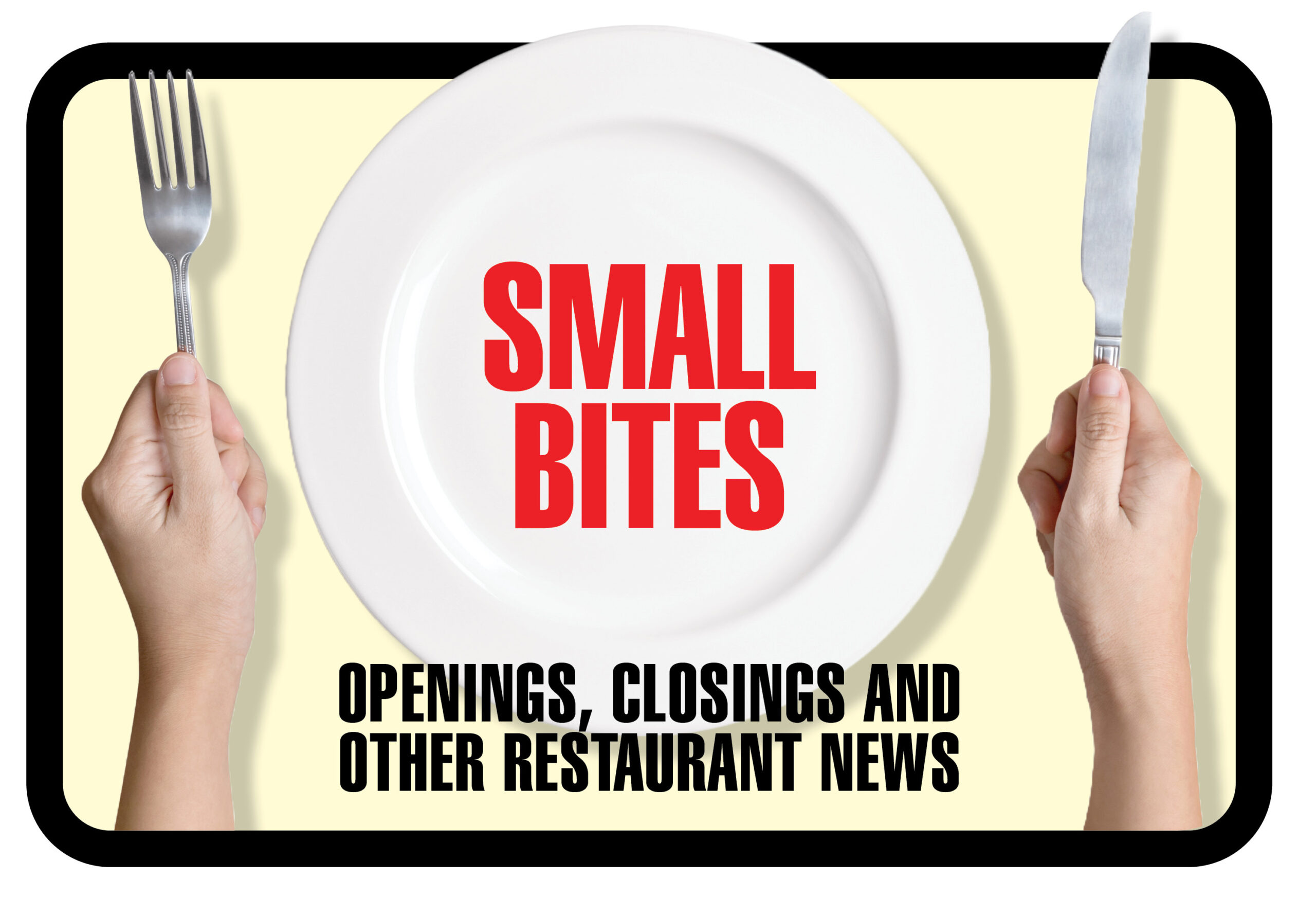Before Prohibition, Missouiri’s winemaking industry was one of the largest in the country, producing 100,000 gallons a year. In 1873, one of the state’s wines won Best of Show at the Vienna World’s Fair. Although the state’s winemaking capabilities are much less now, its wine scene is flourishing.
By: Dawnya Bartsch, Ryan Reed, Ian Ritter, and Tyler Shane
Resurrecting MO’s wine heritage one barrel at a time
TerraVox is more than just a winery— it’s a living museum
By: Dawnya Bartsch
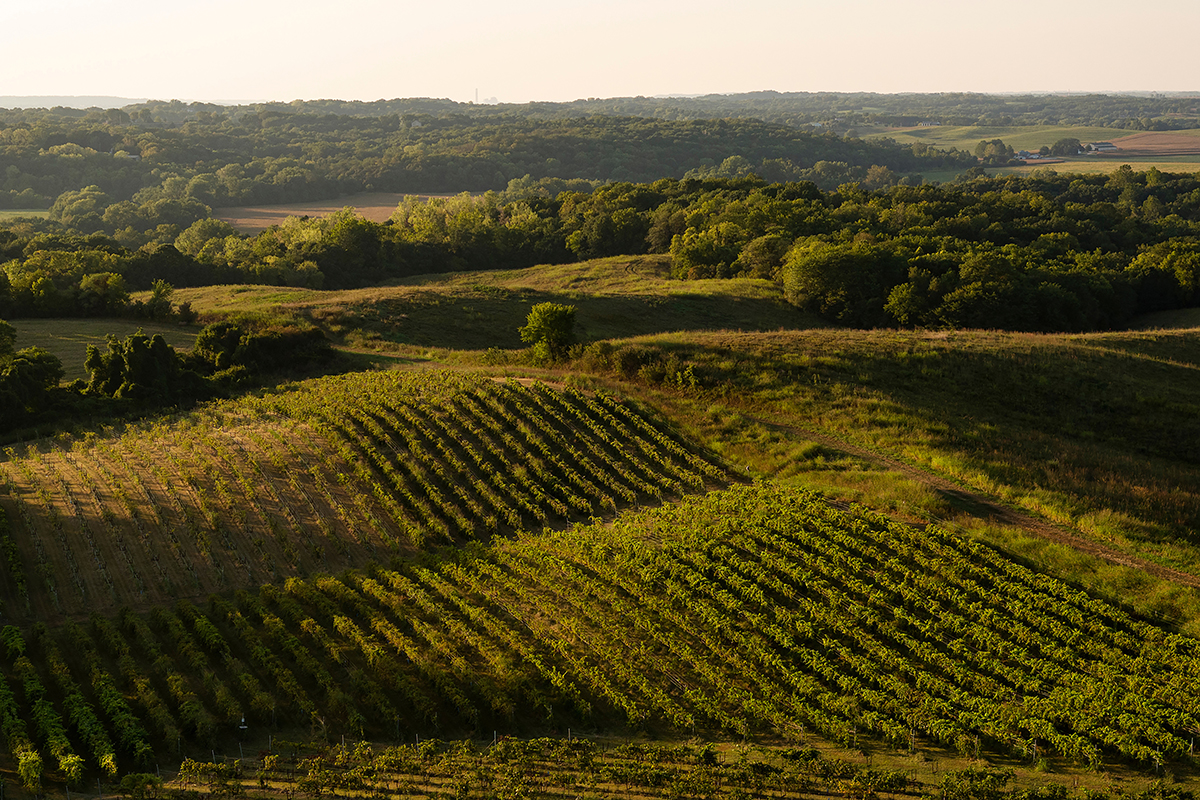
An interactive museum exhibition might be the best way to describe TerraVox Winery.
That’s not surprising considering it’s the brainchild of museum designer Jerry Eisterhold, who almost 30 years ago decided to resurrect America’s forgotten grape varietals and create his Kansas City vineyard near Weston, not far from the airport.
Eisterhold became interested in indigenous American grapes after reading a 1909 book by Thomas Volney Munson chronicling mid-America’s native grapes. Munson is credited with saving Europe’s traditional grape varieties from the continent’s late-1800s phylloxera epidemic. Known as the Great French Wine Blight, the pest invasion nearly destroyed France’s wine business. Munson grafted European varietals onto Missouri rootstock, which was immune to the pest. Munson and others—most notably Missouri’s state entomologist at the time, Charles Riley—sent the rootstock to vintners in France.
Many of the grape species noted by Munson have been lost to time, trends and Prohibition. In 1920, when prohibition hit, Missouri was the second largest wine-producing state in the country, second only to Ohio, but the Show Me State never quite recovered from the nation’s alcohol ban. Munson’s work can be seen as the philosophical foundation of TerraVox Winery. After reading Munson’s book, Eisterhold, who grew up on a Missouri farm and studied agronomy in college before becoming a museum designer, embarked on a mission to collect heritage grape seeds and restore the old varieties.
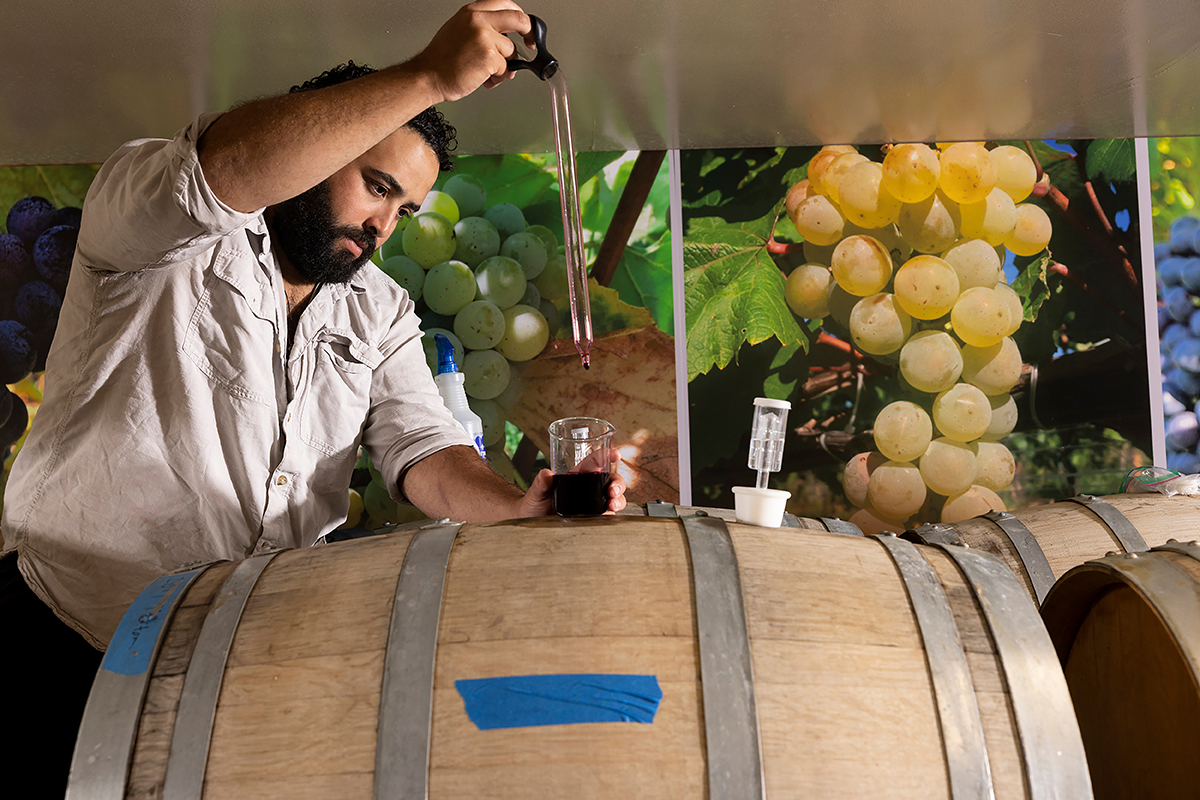
“We are a living, breathing museum,” says Jean-Louis Horvilleur, TerraVox’s winemaker and vineyard manager. Horvilleur, who moved from Texas about five years ago to oversee TerraVox—which means “voice of the land” in Latin—had heard about Eisterhold’s vineyard through business associates and wanted to be a part of his grand experiment. “The grapes here don’t really exist anywhere else,” Horvilleur says.
Making wines from these grapes is a challenge because there is no written record about how to go about it, but that’s also the fun and gratifying part of the process, Horvilleur says.
There is a “little bit of a Wild West approach” to working with relatively unknown grape varietals, Horvilleur says. “We love to experiment. We are constantly learning about the grapes, learning their characteristics.”
They grow Missouri’s state grape, the Norton, of course, but they also grow Cloeta, Albanian and Herbemont, among other obscure varietals that most people have never heard of.
It’s these varietals that TerraVox is always looking to craft into bottles of fine wine.
Since purchasing the 85-acre plot of land in 1996, Eisterhold has grown the vineyard and business. TerraVox now has a tasting room and hosts wine tastings and seasonal events, with plans to open a wine bar this spring.
“We’re always looking for ways to introduce the community to the winery and wines,” says Horvilleur.
For example, right now TerraVox is offering an “igloo experience” through the end of March. Each clear igloo is set out on an outdoor deck, customized with a heating apparatus, and seating, blankets, and decorated for an experience to remember. A bottle of wine and a charcuterie board are included in the reservation.
Another example is TerraVox’s spring wine run. The 5K run/walk takes guests along a trail that winds through the vineyard, culminating with a wine pour at the finish line.
To learn more, check out terravox.wine.
Before Napa Valley, There Was Augusta
Little do most oenophiles know that America’s first official wine region was right here in Missouri
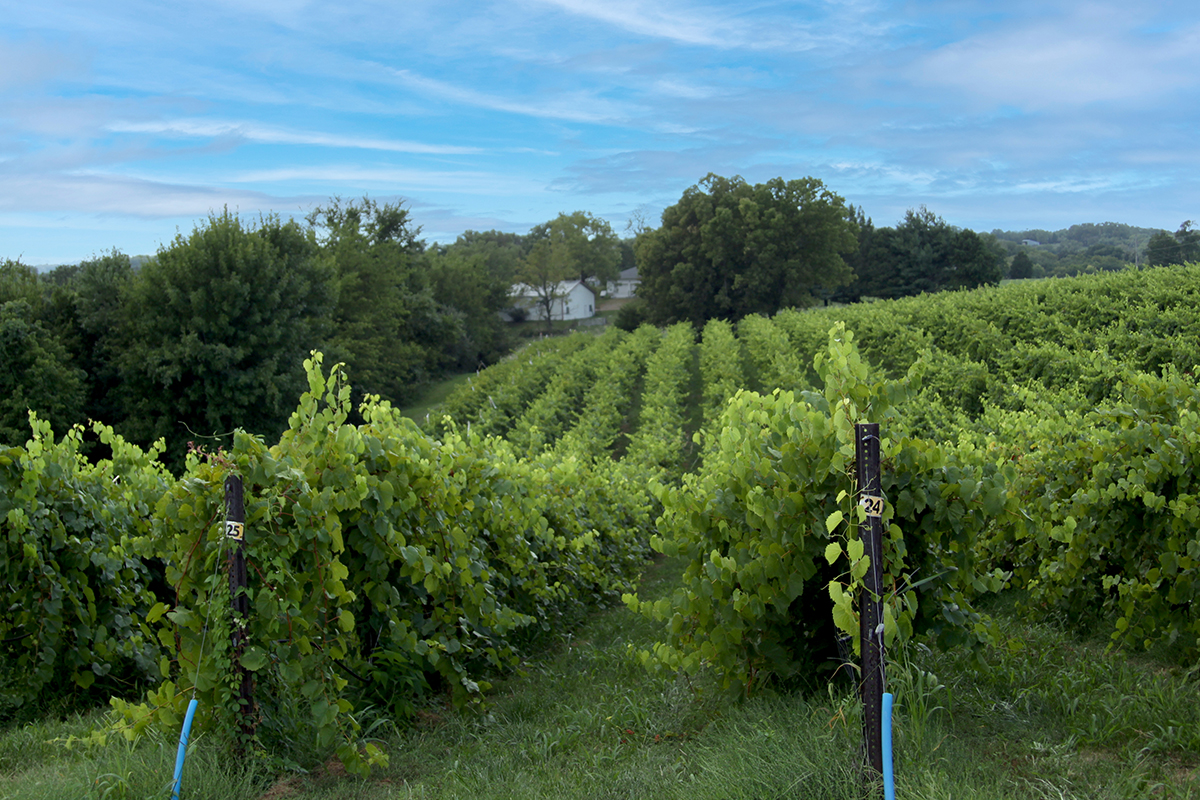
By: Ryan Reed
Forty miles west of St. Louis is the home of the first recognized American Viticultural Area—Augusta, Missouri. Established in 1980 through the Bureau of Alcohol, Tobacco and Firearms, American Viticultural Areas were created to legitimize the production and labeling of wines from specific regions. Now overseen by the Alcohol and Tobacco Tax and Trade Bureau, there are 274 AVAs in 34 states, over half of which are in California.
Missouri—once home to the second largest wine-producing region in the country—and the Augusta AVA have a storied history. Missouri’s oldest winery, Mount Pleasant Estates, was founded in 1859 to take advantage of the area’s abundant and rich grape harvest. In the 1870s, Missouri’s state entomologist, Charles Riley, saved the French wine industry with the help of Augusta vintners by grafting native phylloxera-resistant rootstock with French vine cuttings. For his contribution, a statue of Riley was erected in Montpellier, France. Surviving the financial hardships of Prohibition, the Augusta AVA has steadily climbed back and is still investing in wine tourism in the region.
AVA certification is quite a technical thing. It keeps winemakers honest when claiming where grapes are grown. This protects winemakers who produce in a specific region from less noble ventures that may intend to sell more wine using cheaper methods and ingredients by claiming they were made elsewhere. This geographic certification can bestow a pedigree on wines for enthusiasts seeking bottles from specific locations, such as the Willamette Valley in Oregon and Sonoma County in California. To be labeled from a specific AVA, 85 percent of the grapes must be grown in it, and the wine must be completely finished in the state. Similar certifications exist abroad such as in France (appellation d’origine contrôlée) and Italy (denominazione di origine controllata).
Happy Trails: A guide to Missouri’s 8 official Wine Trails
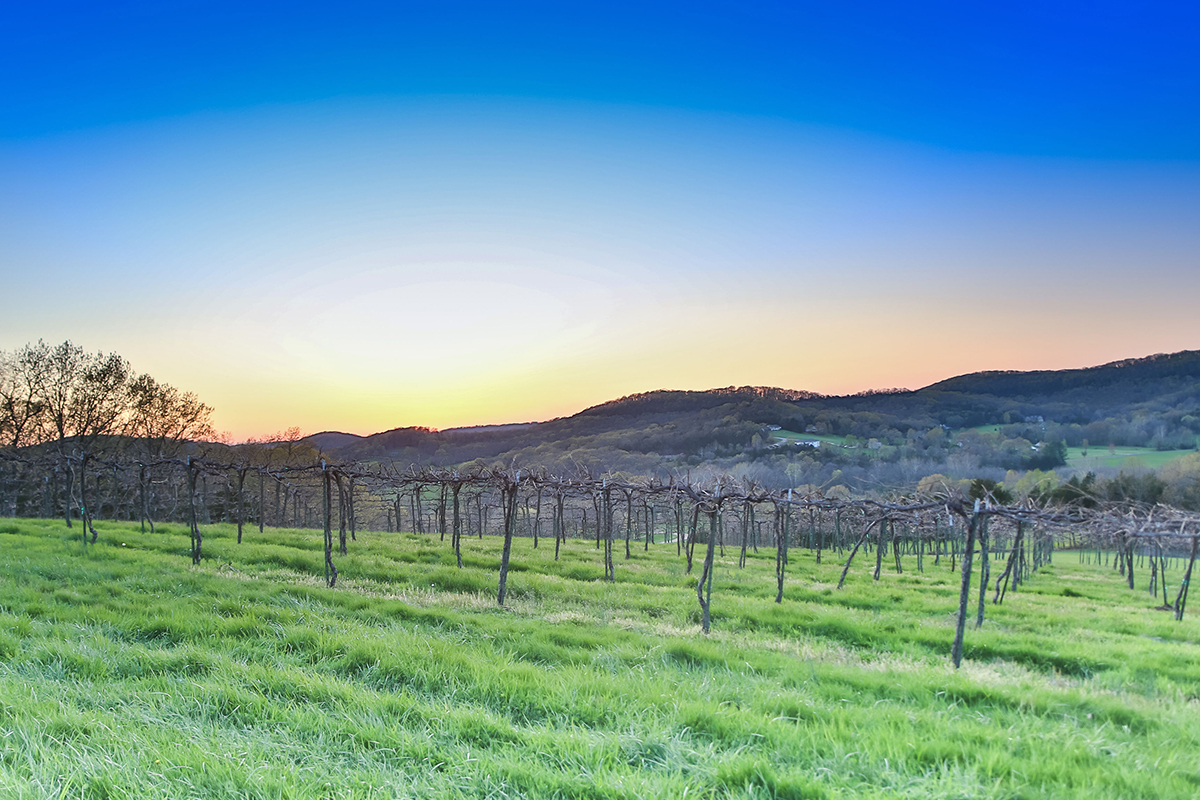
By: Ian Ritter
If you’re looking to get away and spend some time drinking wine in a rural setting and California and France aren’t in the budget right now, why not check out Missouri’s vineyards?
The state boasts 126 wineries, and while Missouri’s vintners might not have the same cache attached to them as those in more exotic locales, you’ll find a rich history of winemaking that predates the Civil War.
The state of Missouri takes wine production and sipping seriously—it operates a wine and grape program simply called “Missouri Wines” through its Department of Agriculture. In 1980, the area around Augusta near the Missouri River, just west of St. Louis, was designated the first American Viticultural Area in the United States, beating out California’s Napa Valley.
It was the area’s first European settlers in the mid-1800s that kickstarted the state’s winemaking industry. Newly arrived Germans opened the first wineries around the Hermann area along an extremely fertile part of the Missouri River Basin.
Italian immigrants in the 1890s did the same in St. James, in the south-central Ozark Highlands part of the state, producing their own distinct wines. Meanwhile, the Missouri wine industry in the 1870s is credited with saving production in France by sending the country rootstock that was immune to the insect that had destroyed much of France’s vineyards in what is known as the Great French Wine Blight.
Now, there are five AVA designations around the state: Augusta, Hermann, the Ozark Highlands, Loess Hills District (in the northwest part of the state) and the Ozark Mountains.
Additionally, nine different grapes are grown in these regions, all with different characteristics, including Catawba, Chambourcin, Chardonel, Concord, Norton, Seyval Blanc, Traminette, Vidal Blanc and Vignoles.
Missouri Wines promotes eight wine “trails” that could serve as weekend-long getaways or shorter trips for Kansas Citians, and there is even a metro-area trail for those pressed for time.
MISSOURI’S OTHER AVA’S
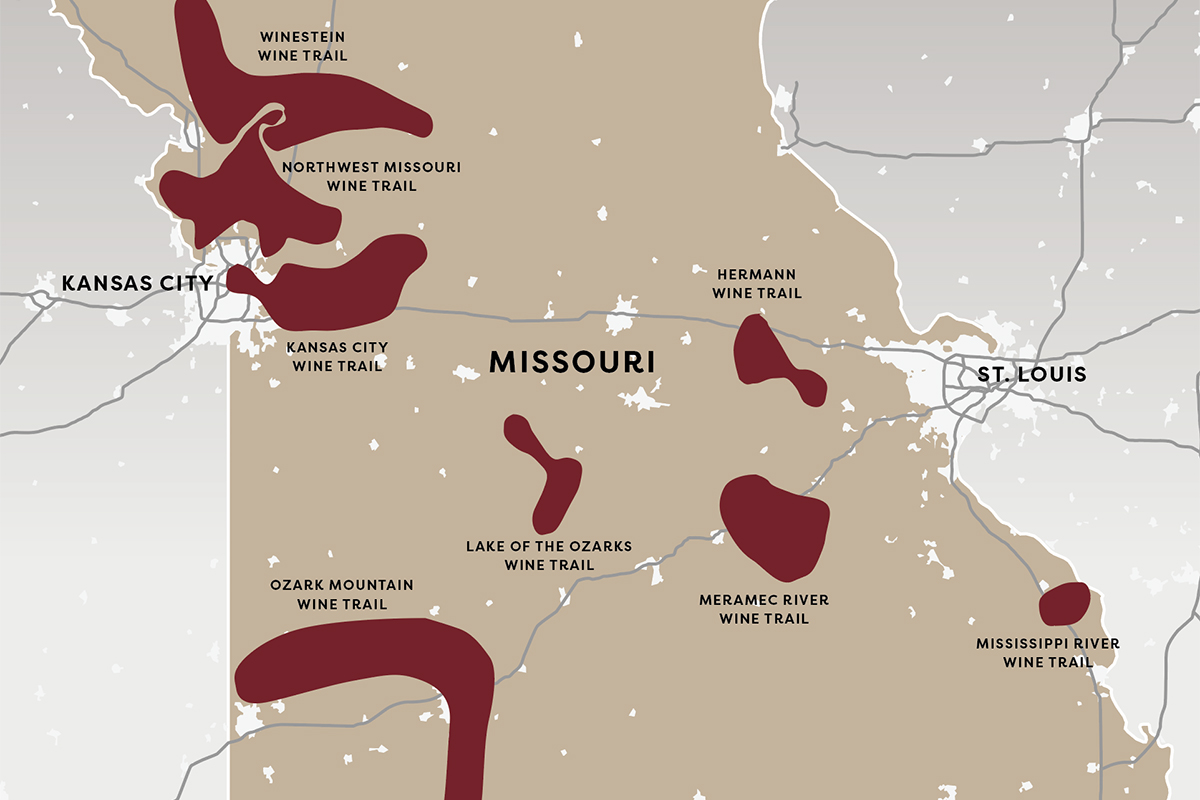
Along with having the distinct honor of holding the nation’s first American Viticultural Area, the state can claim five other AVAs. An AVA is a specific type of appellation of origin used on wine labels.
AVA boundaries are defined and granted by the Bureau of Alcohol, Tobacco and Firearms. At least 85 percent of the grapes that make up a wine must be grown within the boundaries of an AVA for vintners
to claim it on their labels.
By: Ian Ritter
OZARK MOUNTAIN
Recognized in 1986 3.5 million acres in southern Missouri Sixth largest AVA in the United States. This AVA encompasses many of the state’s smaller AVAs listed here.
HERMANN
Recognized in 1983 51,200 acres from St. Louis to Jefferson City German settlers began planting in the 1830s.
OZARK HIGHLANDS
Recognized in 1987 1.28 million acres in south-central Missouri, including St. James Growers began planting grapes in the 1870s.
LOESS HILLS DISTRICT
Recognized in 2016 12,897 square miles of hills in northwestern Missouri This area includes the rolling hills near the Missouri and Big Sioux rivers in the northwest part of the state and the Ozark Mountains.
Hermann Wine Trail

Amtrak trips are a popular way to get to Hermann, a town with outsized German roots about a four-hour drive away from KC. Tourists get a big willkommen right off the bat at the train station and visitor information center.
Guests can choose from several historic inns and bed-and-breakfast-type lodgings as a headquarters from which to visit winery tasting rooms and restaurants that are touted as being “in walking distance of each other.”
Missouri’s oldest wine community features several stops on the trail, including Adam Puchta Winery, Curling Vine Winery, G. Husmann Wine Company, Hermannhof Winery, Reserve Cellars of Hermann and Röbller Vineyard.
Hermann hosts several festivals and food-pairing events throughout the year, like the Farmers’ Table Wine Trail, the Wild Bacon Wine Trail and the Berries and BarBQ Wine Trail. In June, there is the Hermann Plein Air festival, where artists of all skill levels can paint landscapes on plots of pre-approved farmland.
Kansas City Wine Trail

You don’t have to travel across the state to visit a vineyard. The Kansas City area has its own wine trail with several stops along a loop that spans from the West Bottoms to Waverly in Lafayette County.
Several wineries make up the 70-mile KC trail, which features wineries not far from both U.S. Route 24 and Interstate 70. Farthest to the east is Baltimore Bend Vineyard in Waverly, which was founded in 1997 and offers several varietals. About 10 miles west, toward downtown KCMO, is Terre Beau Winery in Dover, with a tasting room housed in a former chapel from the 1800s.
In Independence, in a rural area along the Little Blue River valley, there is the Albonée Country Inn and Vineyards. If you travel south a little over 10 miles, past lakes Blue Springs and Jacomo, Stonehaus Farms Winery grows several wines in rural Lee’s Summit. Further east on Interstate 70 lies Arcadian Moon in Higginsville, and the Odessa Country Winery is just north of the Powell Gardens botanical garden.
Those looking to stay inside the city limits can head to Amigoni Urban Winery in the West Bottoms, which uses grapes grown in Centerview, Missouri.
The Lake of the Ozarks Wine Trail
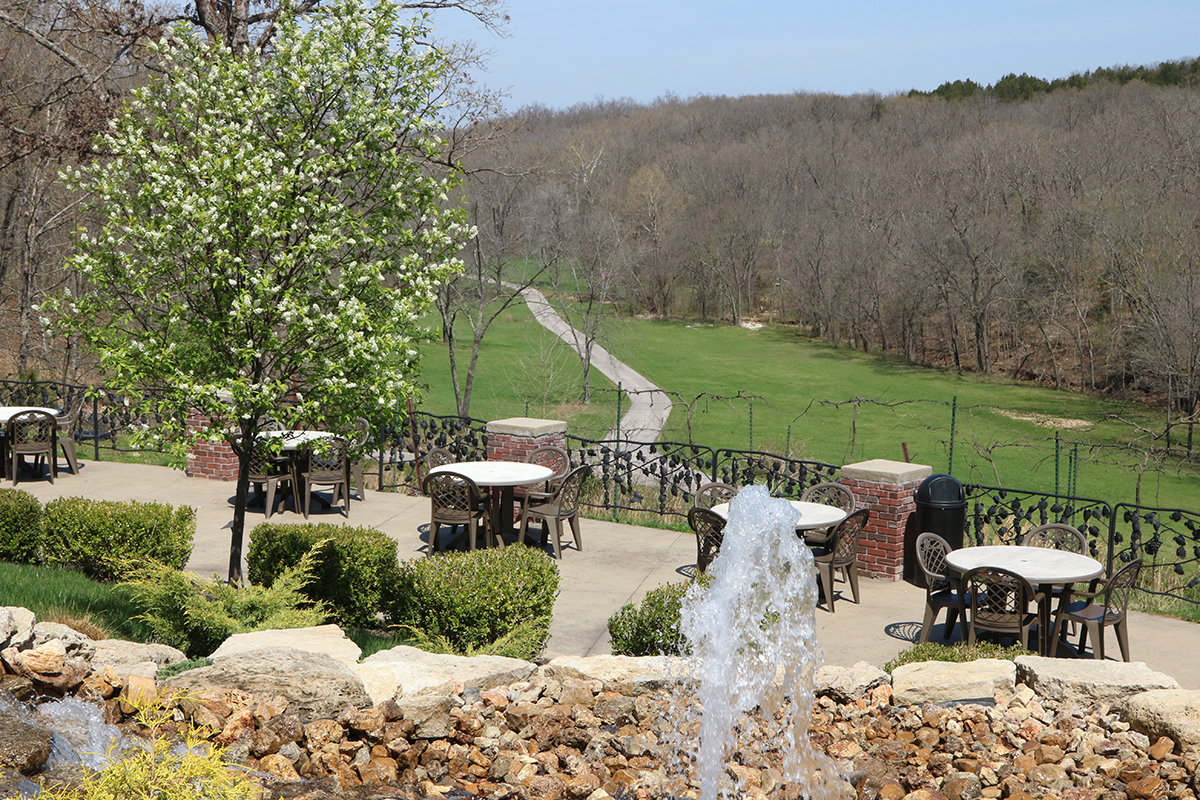
The Lake of the Ozarks Wine Trail offers travelers vineyard experiences a world away from sipping the grape out of a Solo cup in Party Cove.
Dale Hollow Winery in Stover, north of the lake, is open from February through December and has a live music stage in the summer. Seven Springs Winery in Linn Creek, just south of the lake, features a busy live music calendar.
Meanwhile, Shawnee Bluff Winery and Vineyard has two options for visitors—a location on the water by Bagnell Dam at Lake Ozark and the actual Shawnee Bluff Vineyard in Eldon, a town legendary KC saxophonist Charlie Parker used as a quiet retreat to fine-tune his playing.
Meramec River Wine Trail
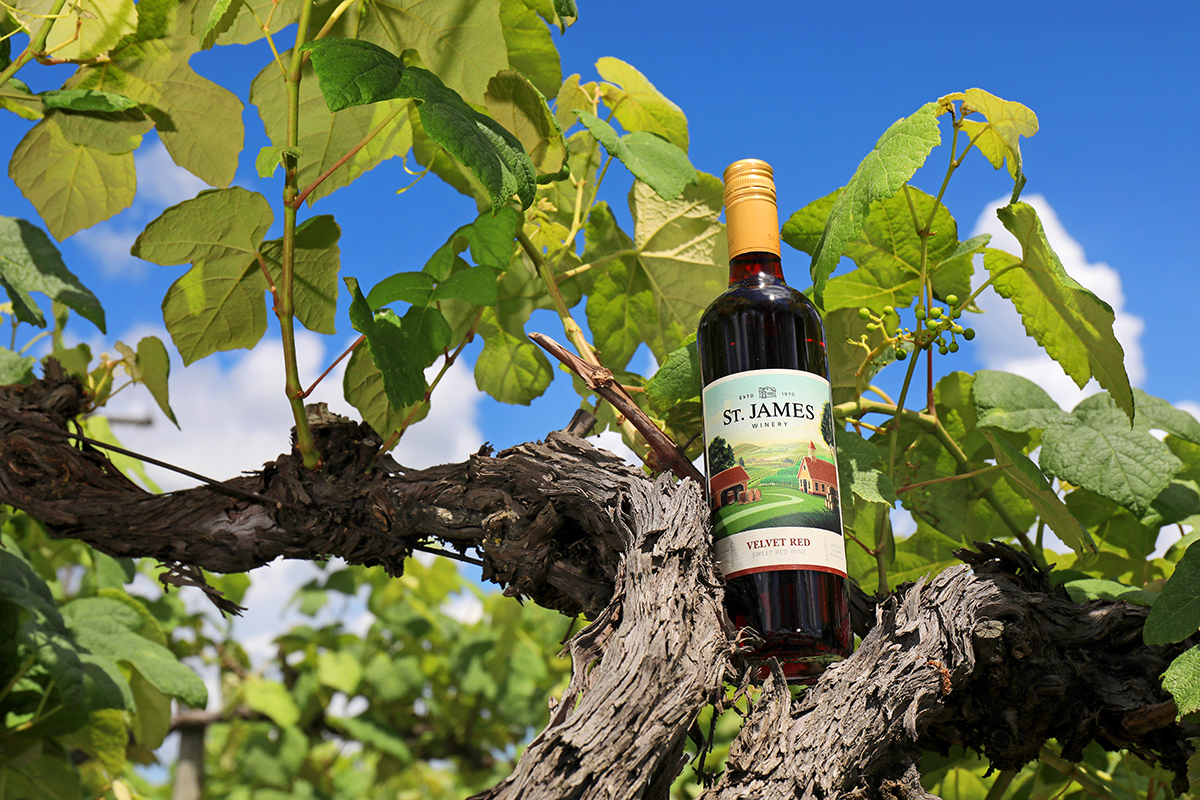
Flowing from south-central Missouri’s Dent County before dumping into the Mississippi River, the windy Meramec wanders along Interstate 44, as do its nearby wineries. This area roughly between the towns of St. James and Mexico near the Ozark Highlands is where Italian immigrants grew Missouri grapes.
St. James Winery, founded in 1970, is one of two in the city and is known as the state’s largest vineyard. Prairie Barn Winery & Christmas Tree Farm is a five-minute drive to the north, where you can grab a Norway Spruce with your bottle of red.
A bit further to the east, in a St. James-area estate known as Rosati, is Eagles’ Landing, which partners with local vineyards to make its wines. About a 50-mile drive to the southeast, you will find Peaceful Bend Winery in Steeltown near the Meramec.
The Mississippi River Hills Wine Trail
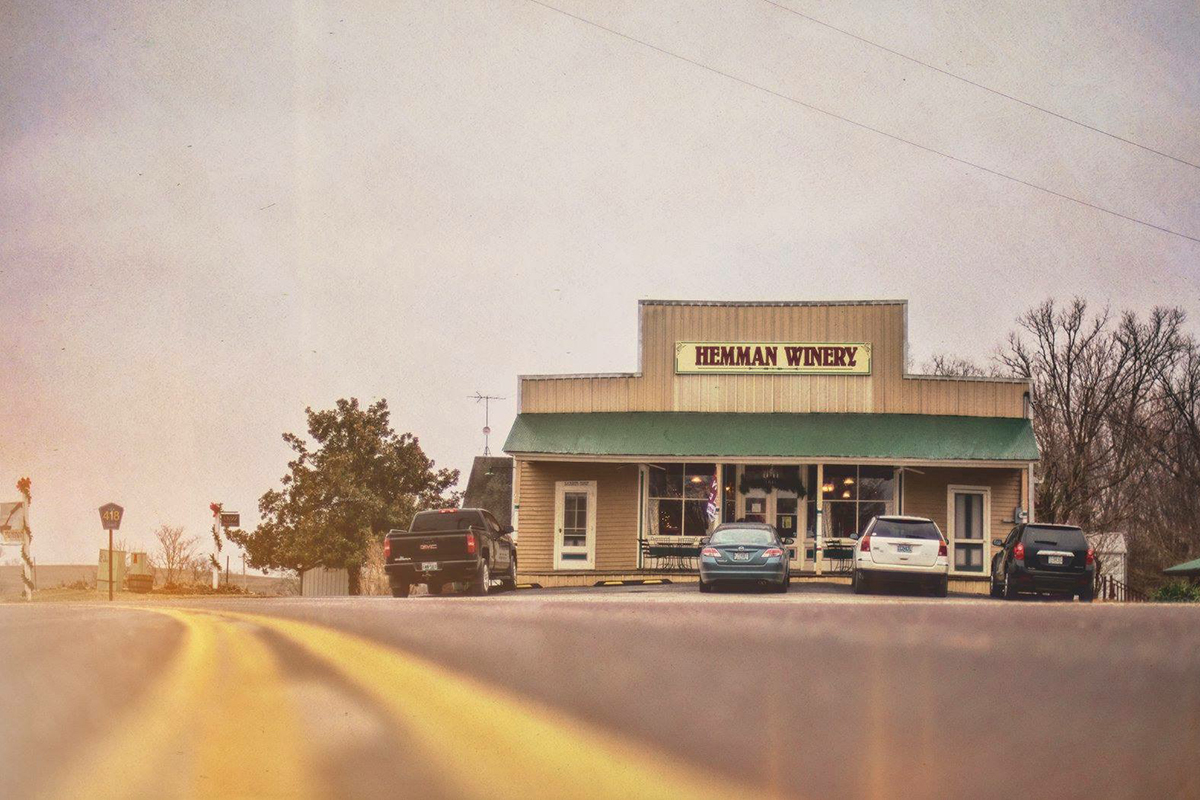
If you find yourself in southeast Missouri near the country’s second longest river, you’ll also find two wineries.
Located between the Mississippi and Interstate 55 is Hemman Winery in Brazeau, which bills itself as “possibly Missouri’s Happiest Little Winery.”
Apple Creek Vineyard and Winery sits close to I-55 in Friedheim. Founded in 2006, the winery’s tasting room overlooking the Mississippi tributary Apple Creek opened in 2012.
CLASS BY THE GLASS: Vintage ’78’s wine list wins global recognition
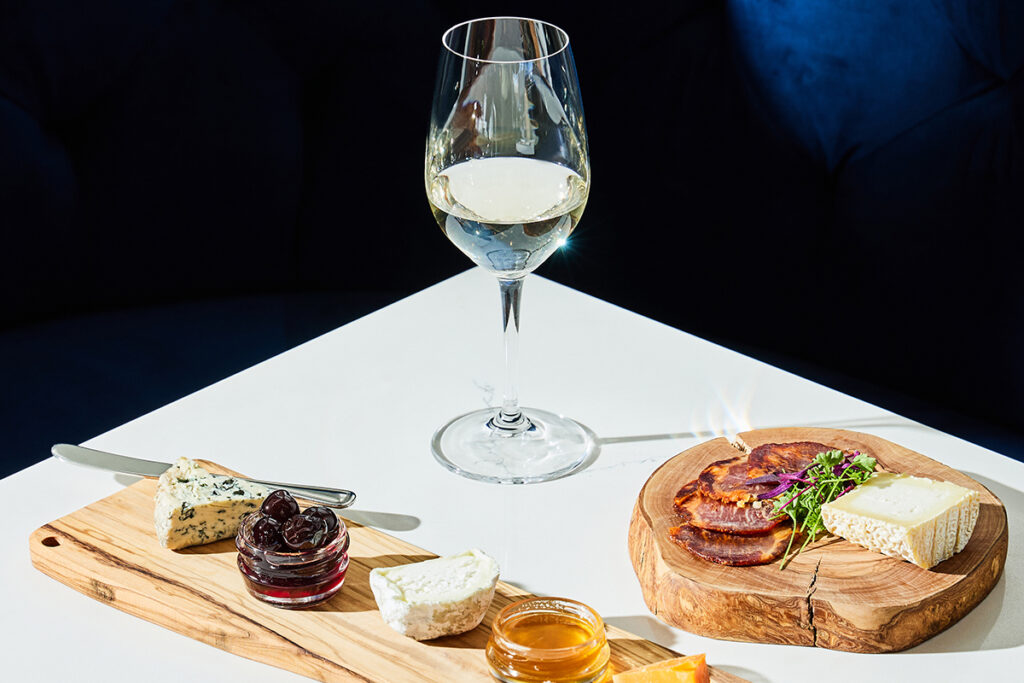
By: Ryan Reed
Overland Park’s wine bar extraordinaire Vintage ’78 is gaining international attention and garnering top accolades from oenophiles across the globe.
Last September, Overland Park’s Vintage ’78 Wine Bar won Best Wine by the Glass List (without Coravin) in the World at the World of Fine Wine Magazine’s World’s Best Wine Lists Awards. The “without Coravin” designation is significant, as Coravin is a pricey technology that extends the quality of an opened bottle for up to four weeks.
Maintaining an award-winning list serving wine by the glass without this technology displays top-tier attention, consideration and service.
Vintage ’78 is owned by Michael Scherzberg and managed by Megan Downes with head chef Kyle Ketchum. The three worked together for years at other establishments before venturing out on their own. Vintage ’78 prides itself on taking guests on a journey, offering clientele the best of the best and unique wine finds from their award-winning wine list. Wine is served in a variety of accommodating sizes, such as a 1 oz taste, 2 oz half-glass, 5 oz fullglass or a full bottle.
This prestigious honor placed Vintage ’78 on the global scene alongside Michelin-starred establishments run by illustrious names like Gordon Ramsay. Vintage ’78 bested other regional winners from across the globe in this category.
“We are amazed and deeply honored to receive this global award from The World’s Best Wine Lists,” says Scherzberg. “This recognition reflects our unwavering commitment to curating an outstanding wine selection and providing an unparalleled dining experience for our guests.”
The Northwest Missouri Wine Trail
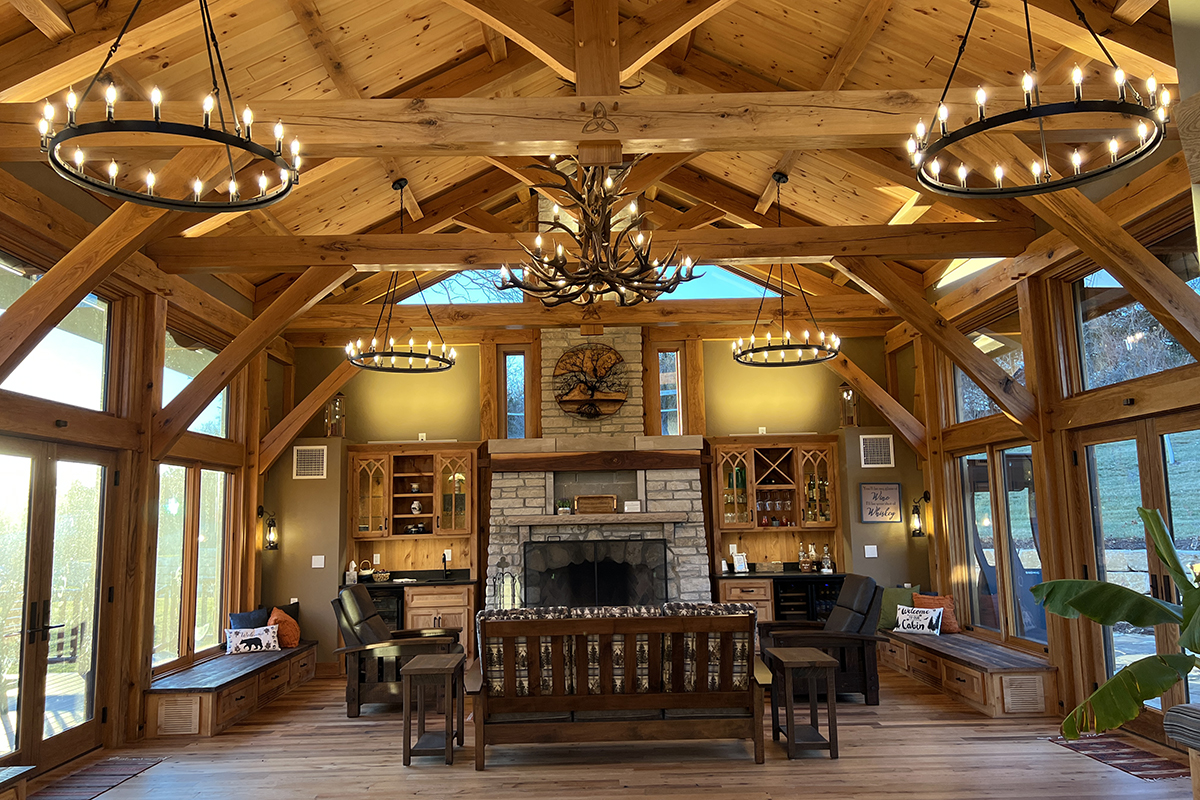
The Northwest Missouri Wine Trail focuses on several wineries north of Kansas City, in an area that reaches from Weston to Excelsior Springs.
Windy Wine Company in Osborn is a little over an hour’s drive north, off U.S. Route 36, and features a corn maze. Toward the southwest near Weston and the Missouri River is Riverwood Winery, which offers regular live entertainment and a whiskey bar.
Speaking of historic downtown Weston, Pirtle Winery, founded in 1978, offers a tasting room among the area’s other small businesses. Jowler Creek Vineyard and Winery is about 10 miles east, in Platte City, and sports a varied events calendar. TerraVox Winery is still in KCMO city limits, with a vineyard just north of Parkville between the Missouri River and KCI.
Over on the Northland’s eastern side in Liberty is Belvoir Winery and Inn, with an attached hotel converted from a former 1800s compound for the charitable Odd Fellows fraternal order.
Excelsior Springs, known for its historic Elms resort, is home to Fence Stile Vineyards, Winery and Distillery, which features a wine cave, and Shamrock Hills Vineyard and Winery, which opened in 2023 on 323 acres.
The Ozark Mountain Wine Trail

The Ozark Mountain Wine Trail spans a wide stretch of Southwest Missouri, from the Kansas border to Springfield to the Table Rock Lake area.
North of Springfield, you’ll find 7C’s Winery in Walnut Grove, which offers wines made with Missouri grapes as well as the honey-derived libation mead. Tyler Ridge Vineyard Winery is in the northern part of Springfield and features a tasting room in a refurbished 1905 barn.
About 20 miles north of Joplin on the Kansas border is Keltoi Winery, located on 43 acres in Oronogo, established in 1997. Just south in Webb City is Christine’s Vineyard, and the winemaker also operates the Vino Noir Wine Bar in downtown Joplin.
Lindwedel Winery is among Branson’s several entertainment attractions and is open most weekends.
Winestein Trail

In the northern part of the state, hugging the Iowa border, is the Winestein Trail, consisting of two wineries 90 miles apart, with Bethany as the center point.
Backyard Vine and Wine is to the west, in Maryville, home of Northwest Missouri State University. It opened in 2008 and has seven varieties on its five acres. Just under 100 miles to the east in the Green Hills area of the state, in Trenton, is Black Silo Winery. It’s open from April 20 to December 22 and hosts special events.
Check Out These Locals With Their Own Wine Labels

Although KC isn’t exactly known for rolling hills of vineyards, we aren’t short on wine lovers and experts. A few of them have even started their own labels and sell them throughout the metro. Here are four labels created by local wine aficionados and connoisseurs.
By: Tyler Shane
Romain Monnoyeur’s Domaine Désiré Petit
Chef and France native Romain Monnoyeur may not have his own wine label, but his family does, and his restaurant, Westport Cafe, is the only place in the U.S. that sells it.
Domaine Désiré Petit was founded in 1932 by Monnoyeur’s great-grandfather Désiré Petit. With vineyards in Pupillin, the renowned winemaking village in the Jura region of France, Domaine Désiré Petit has since been passed down to Monnoyeur’s uncles Gérard and Marcel.
To buy a bottle or try a glass with your meal, head to Westport Cafe. Right now, you can try Domaine Désiré Petit’s poulsard (a light red wine), crémant blanc (a sparkling wine) and crémant rosé (a sparkling rosé). Not sure what to order with your meal? Just ask the server and they will be more than happy to help you pair a Domaine Désiré Petit wine with your food.
Kirk and Julie Berggren’s KC Wine Co.
When the Berggren family bought farmland in Olathe, they had every intention to turn it into a pumpkin patch. The property was already home to a small vineyard, however, and with some convincing from their daughter Taylor, the Berggrens decided to capitalize on that and go full-force into winemaking (they did end up dedicating a portion of the land as a pumpkin patch, too).
KC Wine Co.’s winery and vineyard makes for a great day trip. Head there and you’ll be able to try one of their 14 bottled wines, from a smooth and bright French-inspired seyval blanc to a red wine made with the Norton grape variety, the official grape of Missouri.
Doug Frost’s Echolands Winery
Doug Frost is kind of a big deal. Based in Kansas City, Frost is the one of three people in the world to hold both a Master of Wine and Master Sommelier title. He’s also an author and wine consultant. So it’s about time the wine expert started making his own vino.
Last year, Frost and his business partner, fellow Kansas Citian Brad Bergman, finally opened Echolands Winery in Walla Walla, Washington. On regular rotation are a syrah, bordeaux-style red blend and another red blend made from the neighboring Seven Hills Winery. Although the label has yet to make its way to KC, you can learn more about Frost’s winery and purchase bottles on the Echolands Winery’s website (echolandswinery.com).
Whitney VinZant’s VinZant Wines
Located in northern Sonoma Valley is a 63-acre vineyard owned by local restaurant group owner Whitney VinZant. George Vineyard, named after VinZant’s son, currently produces four wines under the VinZant label: a riesling, a rosé, a red blend and a cabernet sauvignon. Any one of these wines can be tried at several of VinZant’s restaurants, but you’re sure to find them at Gram and Dun on the Country Club Plaza. You can also find the label at your local liquor store.
Missouri Wine varietals
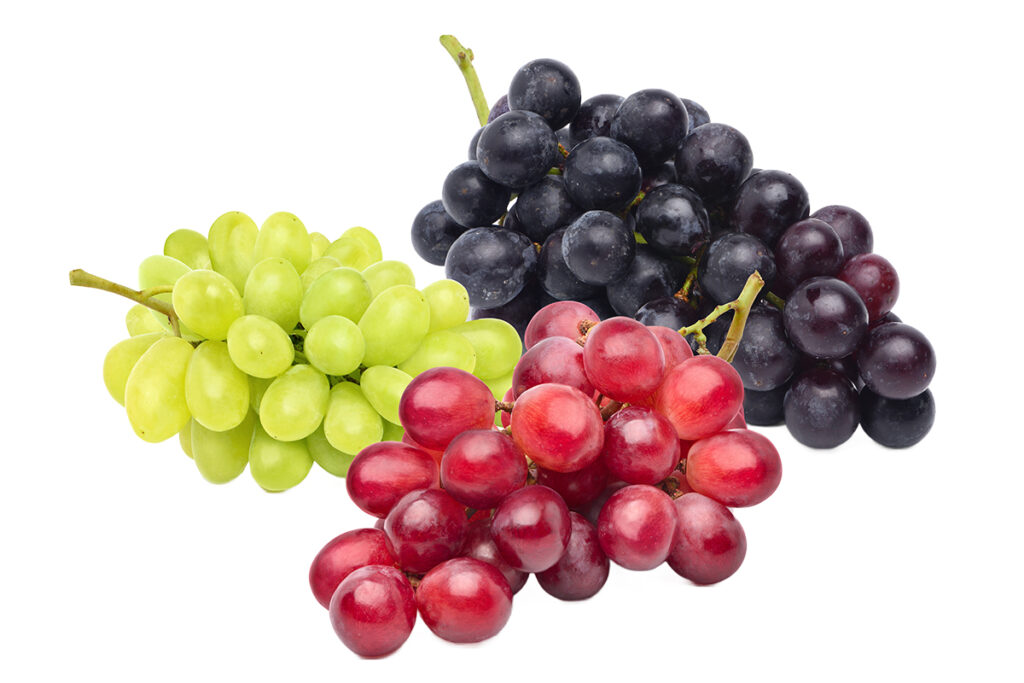
For those not versed in the nine grape varietals grown in Missouri, here they are
By: Ian Ritter
Catawba
Pink and rosé wines
Semi-sweet to sweet
North American hybrid red grape
5.6 percent of grapes grown in Mo.
Chambourcin
Red wines
Dry to semi-dry
French-American hybrid red grape
11.5 percent of grapes grown in Mo.
Chardonel
White wines
Dry
Cross between seyval blanc and chardonnay grapes
3.9 percent of grapes grown in Mo.
Concord
Red wines
Sweet
Originated in Concord, Mass.
6.6 percent of grapes grown in Mo.
Norton
Red wines
Dry
Official Missouri State grape, first found near Richmond, Va., in 1835
17.7 percent of grapes grown in Mo.
Seyval Blanc
White wines
Dry to semi-dry
French-American hybrid grape
2.5 percent of grapes grown in Mo.
Traminette
White wines
Dry to semi-sweet
American child of the German Gewürztraminer grape
5 percent of grapes grown in Mo.
Vidal Blanc
White dessert or sparkling wine
Dry or semi-dry
French-American hybrid since the 1930s
8.2 percent of grapes grown in Mo.
Vignoles
White wines
Dry to sweet
Versatile French-American hybrid
15.5 percent of grapes grown in Mo.
Source: The Missouri Wines organization
Two KC wine experts answer a few FAQs
By: Tyler Shane


Let’s be real: While many of us love and appreciate a glass of wine with our meal, shopping for a bottle or ordering a glass at a restaurant can feel intimidating. What’s the protocol for when the server pours you a sample of wine at a restaurant? What’s the deal with orange wine? What pairs well with spicy Thai food?
We asked Richard Garcia, owner of the Crossroads’ Big Mood Natural Wines, and Sarah Hogan, director of beverage and hospitality at Earl’s Premier and Bacaro Primo, to lend us some words of expertise.
Tips when picking a wine:
Garcia: Personally, I think sticking to rigid rules about pairing white wines with only lighter fare and reds with heartier meals is no longer relevant. Drink what you typically enjoy with your meal.
Hogan: Don’t be afraid to try something new. Show me something from the island of Corsica or made from a difficult-to-pronounce Italian variety I have never seen listed and I’m hooked. These lesser-known wines can also often be of great value compared to some of their more famous counterparts.
Tips on pairing your wine:
Garcia: As a general rule, avoid super tannic wines when enjoying spicy foods. Instead, try an aromatic white wine that has a little residual sugar, like a riesling, muscat, Gewürztraminer or a juicy, lighter-bodied red wine like a pinot noir, gamay, zweigelt, or schiava. Sparkling wines like pét-nats, Cava, Prosecco and Champagne are considered cheat codes when it comes to food pairings. They can be paired with almost anything.
Hogan: At Earl’s Premier, we are known for our incredible oyster selection. Whether it’s a crisp class of Muscadet to pair with a briny East Coast oyster or a full-bodied Champagne to pair with a plump West Coast oyster, it’s hard to go wrong (but I recommend staying away from big reds). Down the street at Bacaro Primo, we are popping bottles of Chianti and nebbiolo to be paired with bowls of pasta and pizzas fresh out of the oven.
What’s the deal with orange wine?
Garcia: Simply put, orange wine is a white wine that ferments on the skins of the grapes for an extended period of time. In doing so, the resulting wine has an amber/orange color. A lot of orange wines are going to fall in the juicy category and will pair well with lighter fare, pizza, tacos and charcuterie.
When ordering wine at a restaurant, what is the protocol for when the server gives you a sample before pouring?
Hogan: The idea is that we want to check the bottle for any flaws that may have occurred during production or shipping. Does this wine taste or smell sour? Does it smell like a browned apple or wet cardboard? These all are signs that something has gone wrong with your bottle of wine, through no fault of the person or restaurant serving it to you. If you taste the wine and you simply do not care for it, let your server know. In all likelihood, they will gladly allow you to accept a new bottle. However, it is important that you help them to understand what you didn’t like about the taste so they can choose a more appropriate bottle for you.
I’m overwhelmed by the wine list at a restaurant. What should I do?
Garcia: If you are at a reputable restaurant, chances are pretty good that all of the wines have been selected with purpose for that wine list. Trust in the service staff to help guide your selection. You never know when you will be introduced to a new favorite wine style or region.
Hogan: Don’t feel shy about asking questions and listening to the advice of your server, bartender or sommelier. The more you can tell them about your personal preferences, the better chance they have at suggesting the ideal wine for you.
Insider’s guide: A comprehensive list of wineries and wine bars in KC and throughout the metro for your bucket list

Wine Bars
Big Mood Natural Wines
2020 Baltimore Ave. Suite 102, KCMO
bigmoodnaturalwines.com
Cooper’s Hawk Winery & Restaurant
Several locations
chwinery.com
Enzo Bistro & Wine Bar
20 E. Fifth St., KCMO
enzokcmo.com
Louie’s Wine Dive
6701 W. 119th St., Overland Park
louieswinedive.com
Mineral Lounge
1700 Broadway Blvd., KCMO
mineralkc.com
Parkville Wine House
305 Main St, Parkville, MO
parkvillewinehouse.com
Sail Away Wine
309 Armour Road, North Kansas City
sailawaywine.com
Tannin Wine Bar
1526 Walnut St., KCMO
tanninwinebar.com
The Pairing Wine Bar & Grocer
1615 Oak St., KCMO
thepairingwinebar.com
Vintage ’78 Wine Bar
7251 W. 80th St., Overland Park
vintage78winebar.com
Vita’s Place
5514 Oak St., KCMO
vitasplace.com
Restaurants with Stellar Wine Lists

Affäre
1911 Main St., KCMO
affarekc.com
Antler Room
2506 Holmes St., KCMO
theantlerroomkc.com
Café Des Amis
112 Main St., Parkville, MO
cafedesamiskc.com
Extra Virgin
1900 Main St., KCMO
extravirginkc.com
Farina
1901 Baltimore Ave., KCMO
farinakc.com
Grünaure
101 W. 22nd St., KCMO
grunauerkc.com
JJ’s Restaurant
4810 Roanoke Parkway, KCMO
jjsrestaurantkc.com
Novel
1927 McGee St., KCMO
novelkc.com
Room 39
1719 W. 39th St, KCMO
rm39.com
The Restaurant At 1900
1900 Shawnee Mission Parkway, Mission Woods
therestaurantat1900.com
Wineries
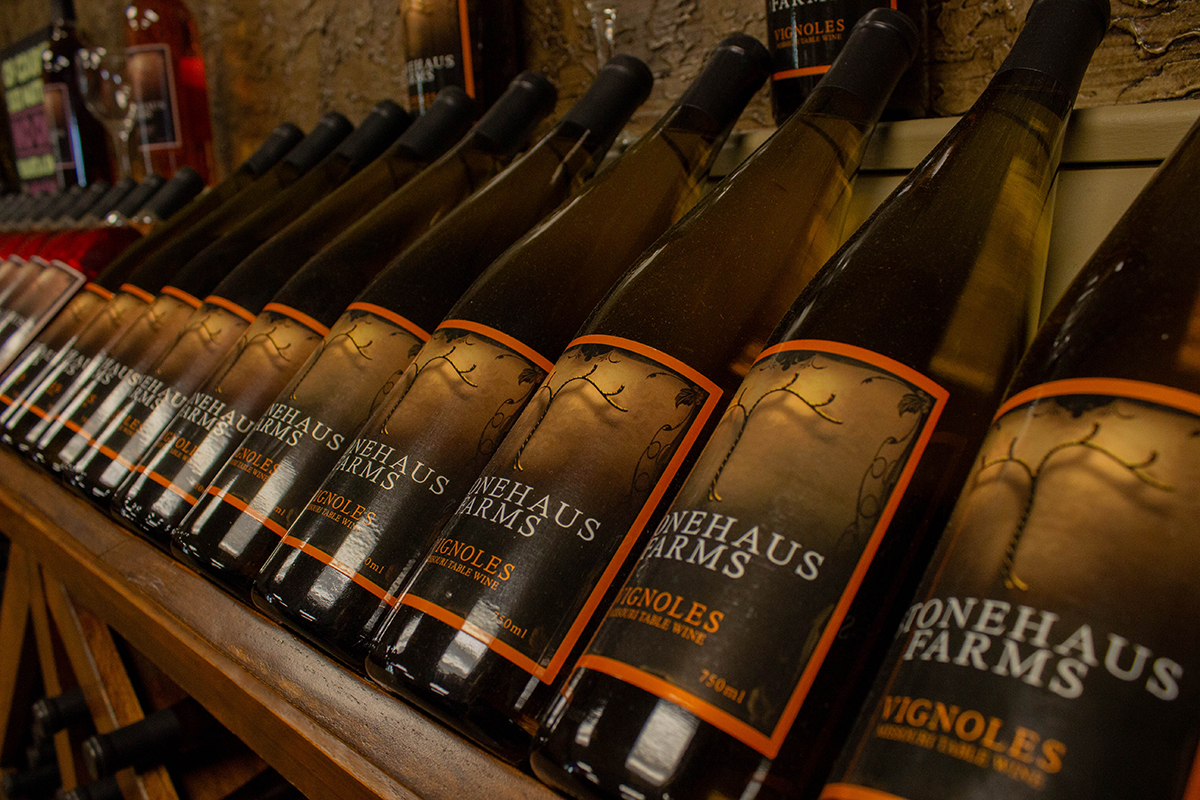
Amigoni Urban Winery
1505 Genessee St., Suite #100, KCMO
amigoni.com
Aubrey Vineyards
16350 Kenneth Road, Overland Park
aubreyvineyards.com
Belvoir Winery & Inn
1325 Odd Fellows Road, Liberty
belvoirwinery.com
Fountain City Winery
1409 W. 11th St., KCMO
fountaincitywinery.com
Jowler Creek Winery
16905 Jowler Creek Road, Platte City, MO
jowlercreek.com
KC Wine Co.
13875 S. Gardner Road, #1, Olathe
kcwineco.com
KC Wineworks
1829 McGee St., KCMO
kcwineworks.com
Stonehaus Farms Winery
24607 N.E. Colbern Road, Lee’s Summit
stonehausfarms.com
Stone Pillar Vineyard & Winery
11000 S. Woodland St., Olathe
stonepillarvineyard.com
TerraVox
19310 N.W. Farley Hampton Road, #3, KCMO
terravox.wine


